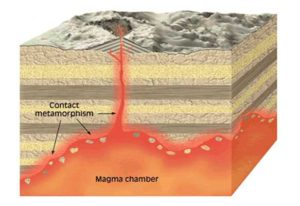
Contact Metamorphism
Contact metamorphism is a type of metamorphism that occurs adjacent to intrusive igneous rocks due to temperature increases resulting from hot magma intrusion into the rock. The metamorphosed zone is known as the metamorphic aureole around an igneous rock.
Metamorphic contact rocks, also known as horns, are often fine-grained and do not show signs of strong deformation. The size of the aureole depends on the temperature difference between the rocks of the wall and the intrusion heat.
In general, dikes have small aureoles with minimal metamorphism while thick and well-developed contact metamorphism has large ultramafic intrusions.
How Contact Metamorphism formed?
There is contact metamorphism where a magma body enters the upper part of the crust. Any type of magma body, from a thin dyke to a large stock, can lead to metamorphism in contact. The type and intensity of the metamorphism and the width of the metamorphic aureole will depend on a number of factors, including country rock type, intrusion body temperature, and body size.
A large intrusion will contain more thermal energy and cool much slower than a small one, thus providing metamorphism with a longer time and more heat. This will enable the heat to spread further into the country rock, creating a larger aureole.
Typically, metamorphic contact aureoles are quite small, ranging from a few centimeters around small dykes and sills to as much as 100 meters around a large stock. Contact metamorphism can occur over a wide range of temperatures— from about 300 ° C to over 800 ° C — and, of course, the type of metamorphism and the formation of new minerals will vary. Also important is the nature of country rock. It will convert mudrock or volcanic rock into horns. Limestone will be transformed into marble and quartzite into sandstone.










